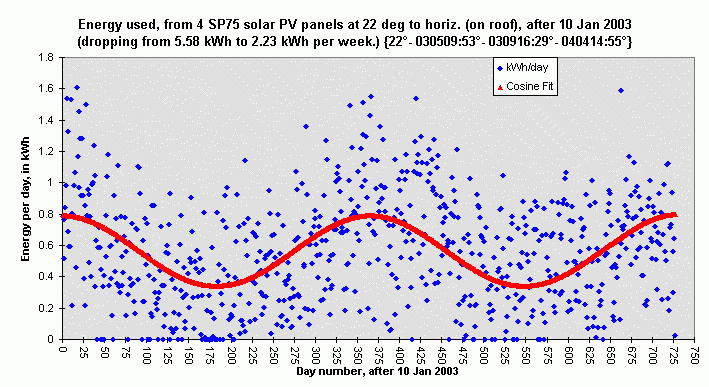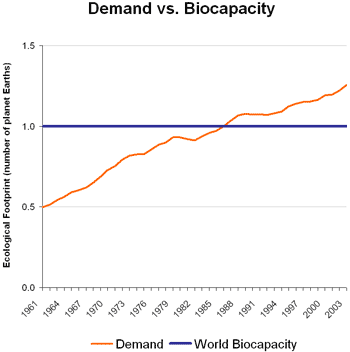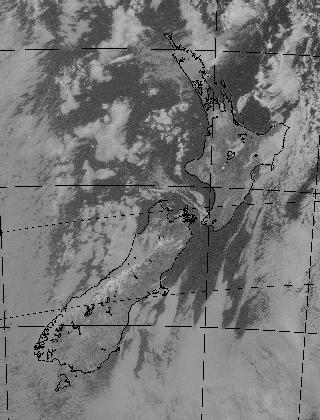| |
|

![]() The
net worth of the 225* richest people in the world now equals the combined income
of the poorest 2.6 billion: 47 % of the world's population.
(UNDP's 1998 Human Development Report)
(* the billionaires)
The
net worth of the 225* richest people in the world now equals the combined income
of the poorest 2.6 billion: 47 % of the world's population.
(UNDP's 1998 Human Development Report)
(* the billionaires)
| (RainForest site; Voluntary Simplicity) |
http://www.footprintnetwork.org/en/index.php/GFN/page/world_footprint/
- starts:
| Summary: | ||||||
|---|---|---|---|---|---|---|
| Country: | Number of earths: | |||||
| Australia: | 5.8 | |||||
| Canada: | 5.7 | |||||
| Cuba: | 0.8 | |||||
| France: | 2.2 | |||||
| Germany: | 3.1 | |||||
| Italy: | 2.5 | |||||
| New Zealand | 3.7 | |||||
| UK: | 3.1 | |||||
| USA: | 6.3 | |||||
| http://www.myfootprint.org/en/about_the_quiz/faq/ - includes: Sustainable area for 1 earth, for one person: 38.83 global-acres or 15.71 global-hectares (conversion factor: 2.471 acres/hectare). |
||||||
| global- | acres /person | version | of table: | |||
| Country: | Carbon Footprint: | Food Footprint: | Housing Footprint: | Goods and Services Footprint: | Total, in acres: | Number of earths: |
| Australia: | 73.7 | 66.4 | 25.1 | 58.9 | 224.1 | 5.8 |
| Canada: | 71.6 | 58.5 | 28.4 | 62.1 | 220.4 | 5.7 |
| Cuba: | 5.7 | 9.8 | 3.9 | 11.3 | 30.7 | 0.8 |
| France: | 31.2 | 28.7 | 10.5 | 15.5 | 85.9 | 2.2 |
| Germany: | 45.7 | 32.3 | 14.6 | 27.1 | 119.7 | 3.1 |
| Italy: | 39.7 | 29.1 | 12.1 | 18.1 | 98.9 | 2.5 |
| New Zealand | 32.6 | 59.2 | 17.2 | 33.2 | 142.1 | 3.7 |
| UK: | 44.7 | 35.1 | 13.7 | 25.5 | 119.0 | 3.1 |
| USA: | 91.4 | 65.7 | 31.6 | 57.7 | 246.4 | 6.3 |
| global- | hectares/pers | version | of table: | |||
| Country: | Carbon Footprint: | Food Footprint: | Housing Footprint: | Goods and Services Footprint: | Total, in hectares: | Number of earths: |
| Australia: | 29.82 | 26.87 | 10.17 | 23.83 | 90.69 | 5.8 |
| Canada: | 28.95 | 23.66 | 11.48 | 25.11 | 89.19 | 5.7 |
| Cuba: | 2.3 | 3.97 | 1.58 | 4.55 | 12.4 | 0.8 |
| France: | 12.62 | 11.62 | 4.25 | 6.28 | 34.76 | 2.2 |
| Germany: | 18.5 | 13.08 | 5.89 | 10.98 | 48.45 | 3.1 |
| Italy: | 16.06 | 11.77 | 4.88 | 7.31 | 40.03 | 2.5 |
| New Zealand | 13.17 | 23.93 | 6.96 | 13.45 | 57.5 | 3.7 |
| UK: | 18.09 | 14.21 | 5.54 | 10.33 | 48.16 | 3.1 |
| USA: | 36.99 | 26.6 | 12.78 | 23.33 | 99.7 | 6.3 |
| Comparison of DM's "answering the quiz" method with Wikipedia|1 | |||||
|---|---|---|---|---|---|
|
Country: |
Number of earths: |
Ecological Footprint |
|
|
|
|
|
|
|
global hectares per capita |
|
|
|
|
DM's quiz (above): |
EF/(EF-1) |
(EF-1: one earth: |
2.1 |
gha/cap.) |
|
Australia: |
5.8 |
3.7 |
7.8 |
|
|
|
Canada: |
5.7 |
3.4 |
7.1 |
|
|
|
Cuba: |
0.8 |
0.9 |
1.8 |
|
|
|
France: |
2.2 |
2.3 |
4.9 |
|
|
|
Germany: |
3.1 |
2.0 |
4.2 |
|
|
|
Italy: |
2.5 |
2.3 |
4.8 |
|
|
|
New Zealand |
3.7 |
3.7 |
7.7 |
|
|
|
UK: |
3.1 |
2.5 |
5.3 |
|
|
|
USA: |
6.3 |
4.5 |
9.4 |
|
|
| _|1: Wikipedia: http://en.wikipedia.org/wiki/List_of_countries_by_ecological_footprint |
|||||
| my World View. |
|
| my Personal Actions. | |
| What
sustainability is, in my view. | |
| Visualising a better Future | |
| How
we live at home, part of "Should one work hard?", [94 kB] or: original letter. 8 kB, & in Aug.'99. | |
| what is
Work for? Is work needed, to be human? | |
| Living on little; some philosophy. & My reason for existence. what I think of my life. | |
| We may retire to an autonomous house; I now have the PV electrical system. | |
| Discussing
some details of my life. | |
| our family
travels in Malaysia and India; ( what we learnt ) |
Two years' solar PV energy use; daily measurements plus a cosine fit: (see link to image, below graph)
|
__ I believe the human race passed a comfortably sustainable population in about 1950, at 2.5 billion, but now there's twice as many of us, and three times as many in twenty years, with a most influential minority using FAR too much. The middle-class and rich have the wrong goals (largely induced by Big Corporates' advertising), if the world is to remain as civilised as it was between '55 and '77 (not including Stalin and Amin).

| __ The more-than-1-billion car-using, meat-eating destructive people (CuMeDs) will need
to drastically reduce both their consumption and what they do! Doing too much,
while there are too many people, should be reduced since this is the origin of
most of our excess consumption. Job-and-income-sharing would be a major step in the right direction. - |
| Graph: http://www.footprintnetwork.org/gfn_sub.php?content=global_footprint |
|
__ I have reduced my demands on the Earth to a
bare minimum by spending US$950 p.a. TOTAL; including no more than US$450 a
year, or $8.65 per week, on food (all of it bought at the
supermarket).
 http://www.oocities.org/davd.geo/ 021015vis00-clearSky-snow200.jpg |
 http://www.oocities.org/davd.geo/ 050804vis21-clearSky-snow320.jpg |
Date: Mon, 9 Oct 2000 16:26:09 +1300 From: David Parker <.-.-.@pop.ihug.co.nz> To: GreenViews New Zealand list <GV-AT-greenLists.org.nz> Subject: [GV] defining the Green vision: a decent standard of living>From The Local Politics of Global Sustainability by Thomas Prugh, Robert Costanza, and
Any more contributions to defining the "decent standard of living"?
regards
David Parker
>At 07:14 6/10/2000 -0700, Diane
Fitzsimmons wrote, to Positive Futures:
>
>My idea of a
decent standard of living:
>Each person has a right to 400 square feet of decent housing. > >Each person has access to round-the-clock public transit. > >Universal health care, including dental and eye > >Free education for all, from birth to 21 > >A non-exploitive job for all from age 18 to when health prevents, but >including and especially the differently-abled. > >Eight sets of decent summer clothing, same number of winter. A winter coat >and other such weather gear. Three pairs of shoes: winter, sneakers, >summer; plus a pair of thongs (shoes). Obviously, this >would change for people living in different kinds of climates. Along with >that, two sets of bedding, extra blankets and other such linens, a table >setting, a teakettle and assorted crockery. > >Decent, healthy food (not sure how to measure this) plus access to the >niceties of life: shampoo, soap, toothpaste, sanitary pads, toilet paper, >razors for those who want them, and other toiletry items. > >a way to cook and preserve food > >Public libraries in all their glory > thank goodness we have achieved that here. > >Access to organized recreation for those who want it in other words, >no-fee team sports > >Winter heating when necessary, fans in the summer when necessary > >One comfortable chair to sit in, a comfortable place to lie > >A radio > >Running, clean water piped to your house > >A bathroom > >21st C. version of a hope chest, with all your personal mementoes(- I later gave my minimum household necessities list : http://au.oocities.com/davdnz/minimumHouseholdNecessities-Molly010225.html
Hello David
... I ... agree that it's an important subject and worth the
effort to try to get the Green movement to think on it.
... the "global celery diet" remark ... could be irritating (or worse), especially out of the context of the entire book.
However, when I read the piece it resonated instantly with Diane's idea of a decent standard of living. What Diane sees as the simple necessities of living comfortably, help map out a sustainable world "that would be nice to live in". Personally I have reached no definite conclusions on where the threshold of sustainability lies and it might well be lower than Diane's list would demand.
At the moment, the significant thing seems to be that anyone is giving any thought to this issue. If someone like Donella Meadows (as quoted within the piece by Prugh) thinks this matter has not been properly addressed, and if it is as serious an omission from the Green political programme as Prugh suggests, then what you and Diane are doing here is very significant.
It is, I think, fundamental practical politics for the following reason. What Greens are saying to millions of people in the developed world is that we must all give up our way of life in favour of something much more modest. The only way we can convince them to do so is with a convincing critique of present-day society which I think we possess and, hand in hand with that, a convincing vision of our alternative. The Green vision is hard enough to grasp at the best of times, and it becomes even more difficult when people start asking practical questions, like "what will my life be like in your sustainable Green future?"
I titled my posting "defining the Green vision" because that is what you are helping to do. It is indeed important.
regards
David Parker
| |
Please send
questions or comments to the site Editor - Try here for the previous version of this page. Includes: mention of  cannabis,
hemp and marijuana. cannabis,
hemp and marijuana. | ||
| |
David MacClement http://twitter.com/davd ZL1ASX latitude=-36.773525 longitude=174.667876 |
||
This is: http://www.oocities.org/davd.geo/index.html (or: http://snipurl.com/6400 )